Human History Written in Stone and Blood
By Zenobia Jacobs, Richard G. Roberts
Two bursts of human innovation in southern Africa during the Middle Stone Age may be linked to population growth and early migration off the continent
Two bursts of human innovation in southern Africa during the Middle Stone Age may be linked to population growth and early migration off the continent

DOI: 10.1511/2009.79.302
Even by archaeological standards, Blombos Cave is a modestly sized shelter. Yet artifacts recovered from just 13 cubic meters of deposit inside transformed our understanding of when our species developed behavioral attributes we associate with “modern” humans.
Even by archaeological standards, Blombos Cave is a modestly sized shelter. Yet artifacts recovered from just 13 cubic meters of deposit inside transformed our understanding of when our species developed behavioral attributes we associate with “modern” humans. From this cramped hole in a sandstone cliff on the Southern Cape coast of South Africa, Christopher Henshilwood and his colleagues unearthed evidence of symbolic expression, in the form of abstract designs (carved ochre bars) and personal ornaments (shell beads) at least 70,000 years old. That is more than 35,000 years before anything comparable emerged in Europe.
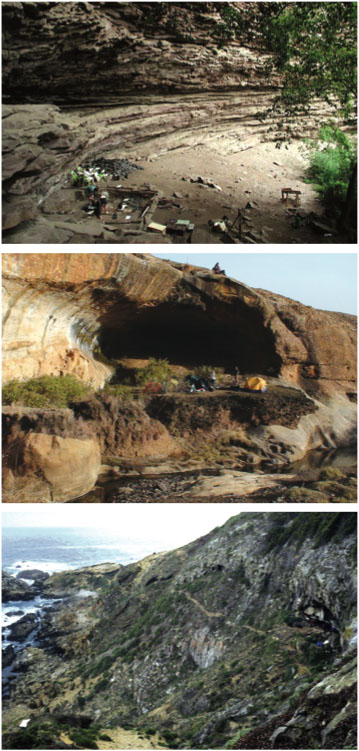
Top photograph courtesy of Lyn Wadley. Middle photograph courtesy of Richard Roberts. Bottom photograph courtesy of Chris Henshilwood.
When these discoveries were first announced earlier this decade, they stood out as extraordinary and provocative—at odds with the prevailing wisdom about the time and place of emergence of symbolic behavior, a trait unique to Homo sapiens. Our modern anatomical features can be traced back almost 200,000 years, based on fossilized remains found in Ethiopia, but the making of the modern mind apparently lagged behind by more than 100,000 years. The remarkable finds at Blombos raised several intriguing questions. What triggered this watershed event in human prehistory? How geographically widespread was it? Did it occur simultaneously elsewhere in sub-Saharan Africa? And what role, if any, did such innovations play in the first steps of the worldwide dispersal of our species?
Important clues come from the stone toolkit that accompanied the crosshatched ochres and deliberately perforated shells at Blombos. Stone tools commonly are the most ubiquitous items at archaeological sites because they survive longer than animal or plant remains. Archaeologists pay close attention to their method of manufacture and how they might have been used. Although much less heralded than engraved ochre and shell beads, the Middle Stone Age deposits at Blombos contained an important assemblage of stone tools known as Still Bay points. These finely shaped lanceolate, or narrow, points are flaked on both sides and probably formed spearhead parts. Discovered in 1866 by Sir Langham Dale near Cape Town, they were among the first type of stone tool described in South Africa. A. J. H. Goodwin, the father of South African archaeology, was the first to appreciate the technological sophistication of this stone-tool industry.
The Still Bay cultural industry is now widely viewed as a phase of precocious and innovative technology within the Middle Stone Age of Africa, preceded by 200,000 years of much less sophisticated stone toolkits. It was followed by another episode of technological innovation—the Howieson’s Poort industry—that includes bladelike tools made blunt on one side and attached to a wooden handle to produce a composite weapon. Like the Still Bay, Howieson’s Poort vanished too. Technology of similar sophistication does not appear again in the archaeological record until the Later Stone Age in Africa and the Upper Paleolithic in Europe, many tens of millennia later.
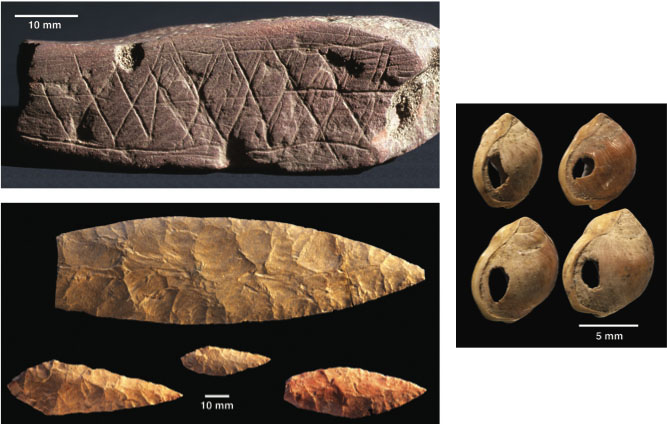
Photographs courtesy of Chris Henshilwood.
The importance of the Still Bay and Howieson’s Poort lies not only in their enhanced technological sophistication with what looks like hunting tools, but also with the range of associated innovative behavioral artifacts. These include the Blombos finds in the south, engraved ochre at Klein Kliphuis and decorated ostrich eggshells at Diepkloof in the west, and bone points and shell beads at Sibudu to the east. These relics of human cognitive advancement imply that an increasingly complex technological and social organization coincided with what some archaeologists now consider a period of expanded human population size and settlement density in Africa. Comparably sophisticated stone-tool technologies also existed in North Africa (most notably the bifacially flaked and stemmed Aterian projectile points found throughout the Maghreb) and, possibly, in East Africa, the suspected launching ground for early human forays off their native continent. Personal ornaments occasionally have been found at those sites as well, including perforated ostrich eggshell beads and pierced shells of marine gastropods.
Efforts to compare the timing of these technological and behavioral innovations to those in southern Africa have long been frustrated by uncertainties in the dating of evidence from each region. As a result, identifying the time and place of the emergence of modern human behavior has eluded us. So have the reasons for, and the immediate consequences of, our ancestors becoming “human.” Solving these puzzles will require more finely resolved dating and chronologies for key archaeological sites across the continent. We started this quest with a systematic dating study of several sites in southern Africa. Our results hint at the possible role of population expansions in Africa as a trigger for these Stone Age innovations—and, maybe, for early migrations out of Africa about 60,000 years ago.
A general problem encountered in trying to date archaeological events or objects is that multiple, independent age estimates are typically more scattered than would be expected with normal statistical variation, even when margins of error for each estimate are considered. Much of this extra spread is an artifact of experimentation—an unwanted but unavoidable outcome of different materials being dated by different methods, using variable equipment, calibration standards, measurement procedures and data-analysis techniques. This complication often arises even when a common set of samples (or a single sample) from one site is dated using the same technique in different laboratories. Unless all experimental conditions, instrument specifications, reference standards and analytical software are identical, extra spread in results should be expected. We call this the chronological “haze” because it obscures the true age of the sample or event of interest.

Stephanie Freese
Many attempts have been made to determine when the Still Bay and Howieson’s Poort industries started and ended, using a range of numerical and relative dating methods. Numerical methods produce quantitative age estimates that can be placed on a standard timescale, commonly expressed as years before present. Relative dating methods produce ages that can be ordered relative to one another but need to be calibrated against a numerical age to get anchored on a timescale. The first and best-known numerical technique is radiocarbon dating, which under ideal circumstances can pinpoint when a plant or animal died in the last 60,000 years. In practice, however, sample contamination makes it challenging to reliably date samples more than half that age, so alternative numerical methods are used for older samples and nonplant or nonanimal materials. Uranium-series dating of calcite formations in caves, electron spin resonance dating of tooth enamel, thermoluminescence dating of burnt stones and optically stimulated luminescence (OSL) dating of sun-bleached sediments have all been applied with varying success to southern African archaeological sites over the past three decades. So has dating of ostrich eggshell by amino acid racemization, a relative dating method. Resulting age estimates for the Still Bay ranged between about 130,000 and 50,000 years ago, whereas the Howieson’s Poort estimates were slightly younger, 100,000 to 40,000 years ago. Such coarse-grained chronologies leave plenty of room for imaginative speculation about the likely duration of these two industries and the reasons for their origins and demise.
In 2006, we began to clear the haze obscuring the Still Bay and Howieson’s Poort industries. We did it by deploying a single dating method, OSL, on the same type of material from a number of key sites, using identical procedures and equipment. OSL offers many advantages. It can capture ages of objects that originate or events that occurred during the entire Middle Stone Age. It produces ages with a precision of better than plus or minus 5 percent. If a single operator can perform the dating, then the precision can be improved further, as can the chances for consistency.
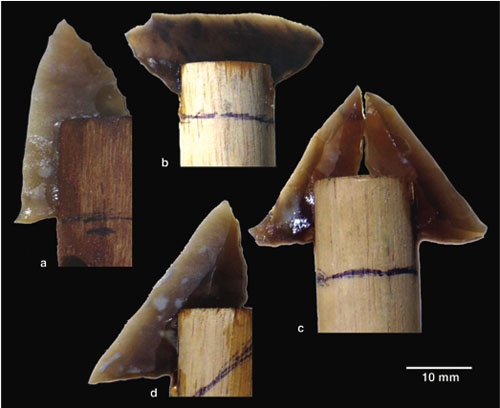
OSL exploits the fact that buried quartz grains absorb energy from natural ionizing radiation sources (mainly uranium and thorium, their radioactive decay products, and potassium) in the surrounding ground. A small fraction of that energy is stored by electrons trapped at defects in the crystal structure of the grains. Using blue or green light, the electrons are released from their traps in the laboratory and the resulting OSL is detected with a filtered photomultiplier. This allows an estimate to be made of the equivalent radiation dose. By also measuring the rate of supply of ionizing radiation to the quartz grains from the surrounding deposit (the environmental dose rate), it is possible to calculate when the grains and nearby artifacts, whether they be stone tools or Stone Age ornaments, were buried.
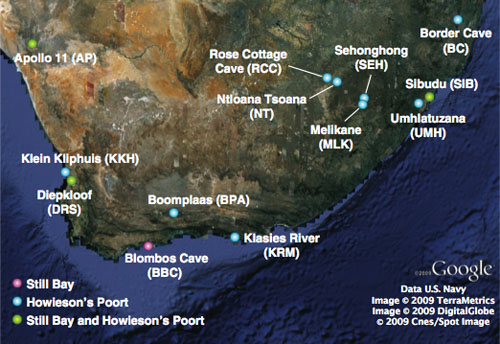
Stephanie Freese
OSL dating was introduced by David Huntley of Simon Fraser University and his colleagues in 1985, primarily to date geological sediments. But the method underwent a revolution near the turn of the millennium, when measurement procedures and instrumentation enabled equivalent radiation doses (and, by inference, burial ages) to be obtained from single grains of quartz as small as 0.1 millimeter in diameter. That made it feasible to routinely measure hundreds of individual grains for every sample, providing multiple, independent estimates of age that could be compared for self-consistency and any signs of sample contamination or disturbance. For our dating of the Still Bay and Howieson’s Poort artifacts, article co-author Zenobia Jacobs collected and analyzed all of the samples in a systematic fashion, eliminating inconsistencies from site to site that plagued earlier dating efforts.
Judging when an archaeological tradition might have started and ended is not simple. It cannot be done solely from artifacts collected at one site because it is unlikely that the entire duration of an industry will be represented at one location. Archaeologists must assemble a series of “snapshots” from multiple sites to get a fix on first and last appearance dates. This is easier said than done, especially in the case of the Still Bay, which has been found at only a handful of spots throughout southern Africa. The situation is much better for the Howieson’s Poort, with around 30 confirmed or claimed occurrences in the high mountains of Lesotho, the desert fringes of Namibia, the continental interior and subtropics of South Africa and the coastal areas and hinterlands along the continent’s southern margin. All the sites are natural shelters and caves that hunter-gatherers used as temporary camping places. Remnants of their everyday activities—fireplaces, food remains and tools—have been excavated at the sites.
Our subcontinental survey included 11 locations that contained one or both of the Still Bay and Howieson’s Poort industries, including some of the classic Middle Stone Age sites of southern Africa, such as Klasies River. Other sites were either not accessible for sampling or, in the case of Blombos Cave, had been dated previously by Jacobs. We intentionally selected geographically widespread sites in diverse environmental settings to capture the full range of natural variability in climatic conditions affecting the region at different times. The deposits at two of the sites proved unsuitable for OSL dating, but a sufficient number of samples (54 in total) were dated from the remaining nine sites to allow us to establish the time of first and last appearance of the Howieson’s Poort and, with less confidence, the Still Bay.

Stephanie Freese
As we reported in Science in 2008, both industries appear to have been extremely short-lived, appearing suddenly and then vanishing soon after. Remarkably, this pattern is seen over an area of 2 million square kilometers, cutting across a range of climatic and ecological zones. Because of the lack of any spatial variation in timing, we pooled all of these data in a statistical model, devised by Rex Galbraith of University College London, to estimate the first and last appearance dates of the Still Bay and Howieson’s Poort. We concluded that the Still Bay lasted no longer than perhaps 1,000 years (from approximately 72,000 to 71,000 years ago). Howieson’s Poort debuted 7,000 years later in the archaeological record, around 65,000 years ago. This industry ended abruptly five millennia later, followed by another gap of about 3,000 years before the first of the subsequent periods of less sophisticated Middle Stone Age technology. The margin of error on these estimates is only a few millennia at the 95 percent confidence interval—sufficiently precise to resolve the ephemeral and punctuated nature of these bursts of technological and behavioral innovation.
Answers about the ages of these artifacts, of course, lead only to more questions. What stimulated the Still Bay and Howieson’s Poort industries? Why did they last so briefly and end so abruptly? And what was responsible for their—in archaeological terms—instantaneous appearance and subsequent disappearance across a vast expanse of southern Africa? Human responses to environmental change have long intrigued archaeologists, so climate change must top the list of suspects. The last interglacial/glacial cycle stretched from about 130,000 to 12,000 years ago, which includes the time span of the Still Bay and Howieson’s Poort. During this period, southern Africa experienced marked changes in temperature and precipitation associated with global changes in ice volume, sea level and patterns of oceanic and atmospheric circulation. The timing and magnitude of these climatic fluctuations have been detected by international climate research groups in the pattern of change in the ratio of oxygen isotopes (and the concentration of atmospheric greenhouse gases) in ice cores retrieved from Greenland and Antarctica. These records share many general features, but the Southern Hemisphere climatic records from Antarctica are the most relevant to southern Africa.
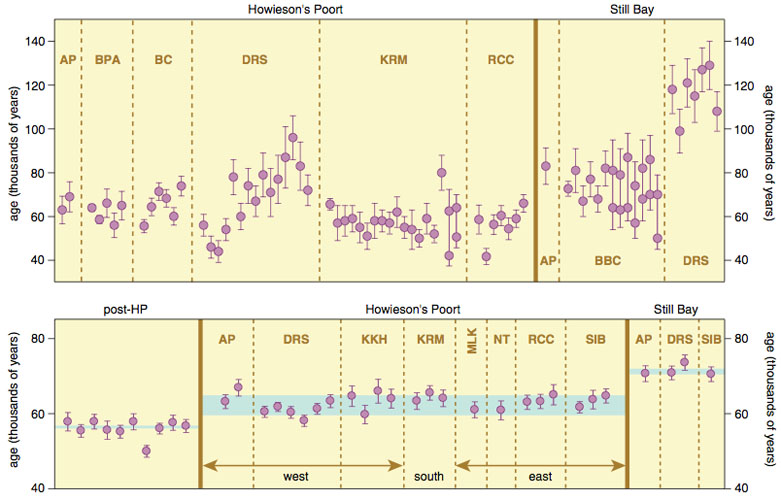
Stephanie Freese
There are uncertainties involved in extrapolating from one continent to the other, and there are some differences in the timing and amplitude of changes among the various Antarctic records. But neither obscures the overall picture: the Howieson’s Poort occurred during a period of climatic warming, whereas the Still Bay cannot be confidently assigned to either a warming or a cooling interval. The fact that the same climatic conditions do not appear to have prevailed during these two episodes of innovation suggests that their emergence and their demise were not driven by a common environmental cause. The lack of correlation between symbolic human expression and a particular type of shift in climate does not preclude the possibility that climatic fluctuations influenced where and when people occupied or abandoned rock shelters. On the contrary, given the lifestyle of hunter-gatherers, the best sites for habitation and access to resources surely changed over time, in concert with environmental changes. In fact, our data hint at the preferential occupation of rock shelters during generally warmer intervals; perhaps more open-air sites were favored at other times.
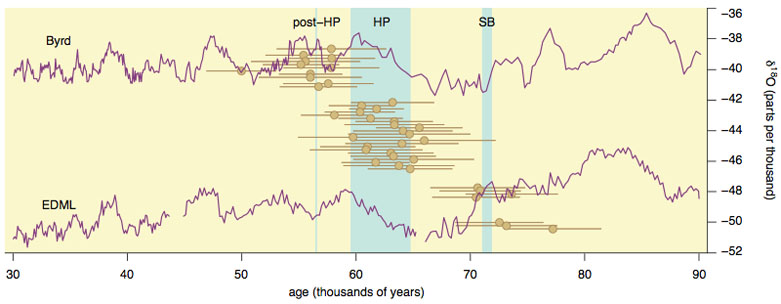
Stephanie Freese
Two further lines of evidence challenge the view that the rise of Still Bay and Howieson’s Poort can be explained simply as responses to environmental factors alone. First, these industries are found in diverse climatic and biogeographic contexts, yet they appeared and disappeared around the same times at various sites. Such synchronicity would not be expected if only certain environmental conditions were conducive to their launch and spread. Second, the Howieson’s Poort was followed by three separate periods of much less sophisticated stone-tool making known as the post-Howieson’s Poort, the late Middle Stone Age and the final Middle Stone Age. No personal adornments or symbolic renderings contemporary to those periods have been found. The latter pair of cultural phases, and possibly the post-Howieson’s Poort, flourished during periods of relative warming—as did the Howieson’s Poort—yet none of them boasts any technological or behavioral innovations. When viewed in this broader context, therefore, the flaring of symbolic behavior during the Still Bay and Howieson’s Poort periods cannot be linked exclusively to a warm, cool or transitional climate.
What, then, might have triggered the onset and termination of these two bursts of creativity and ingenuity? The answer may lie in the history of expansions and isolations of hunter-gatherer populations, as revealed by recent studies of mitochondrial DNA (mtDNA) in living humans. These genetic sequences are inherited maternally, meaning they do not recombine with paternal-source DNA generation after generation the same way nuclear DNA does. Mitochondrial DNA records the pattern of ancient population expansions, declines and isolations, albeit accompanied by a number of assumptions and complications that still thwart consensus on the demographic history of H. sapiens. Still, for sub-Saharan Africa, new genetic data offer a much clearer picture of the major demographic events that affected the diversity and dispersal of our species.
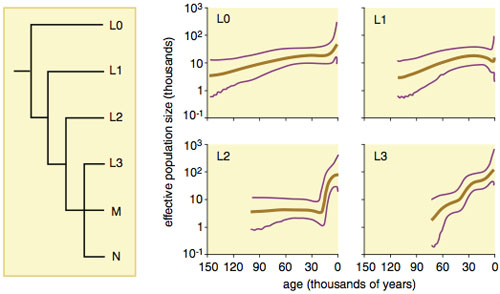
Courtesy of Quentin Atkinson, University of Oxford
One of the most recent studies, by Quentin Atkinson of the University of Oxford and his colleagues, examined four major mtDNA lineages indigenous to Africa—the L0, L1, L2 and L3 groups of haplotypes. The L3 haplogroup is the youngest and is especially interesting because all mtDNA lineages found outside of Africa derive from just two haplogroups (M and N) that descend from L3. Intriguingly, when the timing and pattern of expansion of the four major haplogroups were estimated for the last 150,000 years, the first marked increase in population size began some time between 86,000 and 61,000 years ago in the L3 haplogroup—a time span that includes the Still Bay and Howieson’s Poort. No other haplogroup expanded substantially until more recently than 20,000 years ago.
It is tempting to link the population explosion of the L3 haplogroup with significant environmental events that occurred about 75,000 years ago. As recently reported by Christopher Scholz of Syracuse University and his colleagues, 60,000 years of severe drought in East Africa ended around that time, followed by the onset of generally wetter and more stable conditions. Also, the supereruption of the Toba volcano on the island of Sumatra—the largest eruption known to have occurred on Earth since the emergence of the genus Homo—occurred about 74,000 years ago. The injection of volcanic ash and aerosols into the atmosphere is thought by some scientists to have triggered a brief, so-called volcanic winter around the world that reduced the size of human populations. But the breaking of East African megadroughts cannot account for the demographic expansion of only one of the four haplogroups. And the Toba supereruption is incompatible with the observed increase in size of the L3 haplogroup. As a result, Atkinson and his colleagues have dismissed environmental change as the sole factor responsible for the rapid growth in L3 populations and the migration of their descendents out of Africa 10,000 years later.
As an alternative explanation, they proposed that some form of cultural innovation and increase in behavioral complexity by members of the L3 haplogroup gave them a competitive edge over rivals, perhaps by improving technological efficiency, economic productivity, social cohesion and group coordination. Our new ages for the Still Bay and Howieson’s Poort industries place them squarely in the same time frame as these estimated human population expansions. We cannot say whether their innovative attributes were a cause or a consequence of the L3 expansion. But the latter would seem more likely, given the thousands of miles separating southern Africa from East Africa, where the L3 haplogroup is most diverse and is thought to have originated. But resolving cause and effect here requires a fine-tuned chronology for the L3 expansion, so that its precise timing can be compared with the start and end dates of the Still Bay, the Howieson’s Poort, and the similarly sophisticated stone toolkits in North and East Africa.
On the flip side of the demographic coin are records of population isolation also preserved in mtDNA. There is an emerging consensus that our species experienced several such episodes in sub-Saharan Africa, and did not always form a single, geographically continuous population. Particular attention has been paid to the L0 haplogroup, which is the most ancient of the African mtDNA lineages and has two branches (L0d and L0k) that are most prevalent among the Khoi and San (Khoisan) “Bushmen” of southwest Africa. The Khoisan still live a hunter-gatherer lifestyle and are famous for speaking a “click” language. Recent studies of complete mtDNA genomes have revealed that the Khoisan became genetically isolated more than 90,000 years ago. Only with the advent of the Later Stone Age—tens of millenia later—was there renewed genetic admixture in the Khoisan mtDNA pool, supporting a deep ancestry for this language family. A similar demographic pattern has been uncovered in tropical central Africa, using the L1c haplogroup to trace the mtDNA history of isolation of Pygmy hunter-gatherers. The ancestors of these equatorial rainforest dwellers became genetically isolated no later than about 74,000 years ago, with gene flow resuming about 40,000 years ago. At present, we also cannot rule out the possibility that the L3 haplogroup experienced episodes of population isolation, superimposed on a general trend of growth and lineage diversification between 80,000 and 60,000 years ago. Is the similarity in timing of these major demographic shifts in sub-Saharan Africa and the ages for the Still Bay and Howieson’s Poort mere coincidence? We think not.
Successive pulses of population expansion and contraction in southern Africa might explain why the Still Bay rose to prominence so abruptly across such a large area and then vanished in less than a millennium, and why the Howieson’s Poort began 7,000 years later and lasted about 5,000 years. For technological and behavioral innovations to be spread widely and rapidly, a cohesive network of social contacts is needed to promote the transmission of new ideas and inventions. Periods of population expansion of the L3 haplogroup could conceivably have created such a network and prompted geographically widespread trade and exchange of high-quality stone and symbolic artifacts across southern Africa. In this hypothesis, the gap between the Still Bay and the Howieson’s Poort represents a period of population contraction, during which social networks weakened or collapsed. The reasons for this calamity remain an enigma, but perhaps the prevailing cooler conditions altered the balance of nature, triggering a change in the distribution, diversity, predictability and productivity of resources needed by hunter-gatherers. If people were forced to abandon habitation sites and to move to find sustenance, links in the social network could have been strained or broken, isolating new innovations to smaller groups with limited geographic dispersal.
It might have taken another explosion in population size to reinvigorate this social network across southern Africa, resulting in the widespread transmission of the latest technological innovation associated with the Howieson’s Poort (backed blades for hunting weapons). This integrated, subcontinental network of hunter-gatherer communities was maintained for more than five millennia, but then disappeared about 60,000 years ago, perhaps in response to the population contractions and isolations identified by genetic studies. Similarly sophisticated stone-tool technology did not reappear for another 20,000 years—the end of the Middle Stone Age in East Africa—when there is evidence for renewed gene flow south of the Sahara.
The hypothesis offered above is a mix of fact and fiction, imaginative storytelling based on disparate datasets, some of which are better constrained than others. But it is consistent with computer simulations carried out by Stephen Shennan of University College London in 2001 that posit that cultural innovations are more likely to be kept and shared in larger rather than smaller populations. Periods of population expansion would be more likely to produce successful transmissions of technological and behavioral innovations—such as those associated with the Still Bay and Howieson’s Poort. And such novelties would likely have been lost when populations shrank and became isolated. If cultural differences developed among segregated populations, then recent model simulations suggest that migration between groups would have been discouraged and demographic growth further impeded. The rise and fall of the Still Bay and Howieson’s Poort may most likely be linked, therefore, with the demographic history and social fabric of our hunter-gatherer ancestors.
The challenge before us now is to transform speculative claims into robust inferences. The quest to understand the emergence of modern human behavior and our ancestors’ dispersal from Africa will require insights from archaeology, ecology, genetics, linguistics and climate science. There is also a clear need for reliable dating of key archaeological, genetic, demographic and environmental events, and the placement of each on a more finely resolved and standardized timescale. At present, we cannot explain the population expansion of the L3 haplogroup in sub-Saharan Africa as the direct outcome of any particular environmental event. In fact, the timing of climatic and demographic changes is too imprecise to confidently plot them in correct chronological order. Perhaps it was a spark of human ingenuity among a group of L3 carriers in East Africa that was the catalyst for cultural innovation. And perhaps that innovation encouraged social cohesion and the more efficient use of natural resources, prompting rapid population growth among this group of people. This population expansion may have, in turn, promoted more innovations—including the Still Bay and Howieson’s Poort in southern Africa—and the migration of people out of Africa to the north. A crucial next step is to resolve the timing of the main cultural phases in North and East Africa with a precision similar to what has been accomplished for southern Africa. We must position all of these archaeological turning points on the same chronological yardstick with the major climatic, genetic and demographic events on the continent. By arranging events in the correct sequence on the same time line, it may be possible to establish cause and effect—action and reaction—and produce a more informed model of modern human prehistory.
Click "American Scientist" to access home page
American Scientist Comments and Discussion
To discuss our articles or comment on them, please share them and tag American Scientist on social media platforms. Here are links to our profiles on Twitter, Facebook, and LinkedIn.
If we re-share your post, we will moderate comments/discussion following our comments policy.